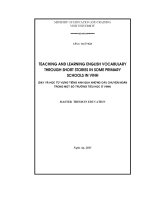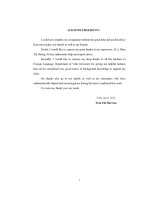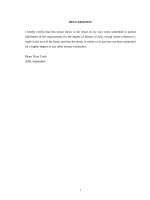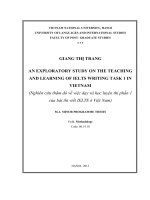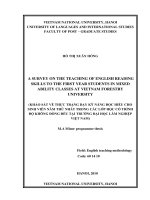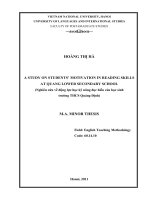A survey on teaching and learning English reading skill at Vietnam Maritime University Khảo sát tình hình dạy và học kỹ năng đọc hiểu tiếng Anh tại Đại học Hàng Hải Việt Nam
Bạn đang xem bản rút gọn của tài liệu. Xem và tải ngay bản đầy đủ của tài liệu tại đây (689.7 KB, 54 trang )
ACKNOWLEDGEMENTS
I would avail myself of this opportunity to express my thankfulness to my
leaders, my colleagues in Faculty of Foreign Studies for their material support,
encouragement as well as their constructive comments and criticism.
I also wish to thank the students of high quality class and especially a group of
six teachers of English from Faculty of Foreign Studies, Vietnam Maritime
University for their wholehearted cooperation with and suggestions for
completion of the survey questionnaires in particular and the thesis in general.
Last but not least, my sincere thanks would go to my family who have
constantly supported, inspired and encouraged me during the time I carried out
this study.
1
ABSTRACT
For students from high - quality classes in Vietnam Maritime University
(VMU), English reading skill takes a very important role in their foreign
language learning. It is undoubtful that reading helps students to improve other
language skills, improve their background knowledge and initially prepare them
for their learning ESP in the following years. This study is aim to give some
possible suggestions for the improvement of teaching reading skill to the high quality students in VMU. These suggestions were due to the results of an
investigation into the teaching of reading skill to the students in high – quality
classes. The researcher has carried out this investigation into the teaching
reading skill by delivering survey questionnaires to 150 students in high –
quality classes and 6 English teachers in VMU. To give an analysis to the
collected data, the researcher used both quality and quantitative technique.
Through analyzing the data, the researcher managed to find out students’ interest
in learning reading skill, then to get a full understanding of their difficulties in
learning this skill and propose some solutions to enhance the efficiency in
learning of students and teaching of lecturers.
2
TABLE OF CONTENTS
ACKNOWLEDGEMENTS ................................................................................ 1
ABSTRACT ......................................................................................................... 2
TABLE OF CONTENTS .................................................................................... 3
LIST OF ABBREVIATONS .............................................................................. 5
LIST OF TABLES .............................................................................................. 7
PART A: INTRODUCTION .............................................................................. 8
I. Rationale........................................................................................................ 8
II.
Aims of the study ....................................................................................... 9
III. The research questions ........................................................................... 10
IV. Scope of the study.................................................................................... 10
V. Methods of the study .................................................................................. 10
VI. Significance of the study ......................................................................... 10
VII. Design of the study .................................................................................. 11
PART B: DEVELOPMENT............................................................................. 12
CHAPTER ONE: LITERATURE REVIEW ................................................. 12
1.1. Definition of reading comprehension ...................................................... 12
1.2 .Models of reading process ......................................................................... 13
1.2.1. Bottom – up model.................................................................................... 13
1.2.2. Top - down model ..................................................................................... 14
1.2.3. Interactive model ...................................................................................... 15
1.3. Features of an effective reading lesson ..................................................... 16
1.4. Reading problems and solutions ............................................................... 17
1.5. Stages of a reading lesson .......................................................................... 19
1.5.1 Pre – reading stage .................................................................................... 19
1.5.2. While – reading stage ............................................................................... 20
1.5.3 Post – reading stage................................................................................... 20
CHAPTER TWO: RESEARCH METHODOLOGY.................................... 22
2.1 The context ................................................................................................... 22
2.1.1. The learners .............................................................................................. 22
2.1.2 The teachers ............................................................................................... 23
2.1.3 The syllabus ............................................................................................... 23
2.1.4 The teaching and learning condition ....................................................... 23
2.2. A survey on the teaching of English reading skills to the first year
students in high quality classes in VMU ......................................................... 24
2.2.1 The informants .......................................................................................... 24
2.2.2. Data collection instruments ..................................................................... 24
2.2.3. Data collection procedure ........................................................................ 25
CHAPTER 3: RESULTS AND DISCUSSION .............................................. 27
3.1. Results and discussion................................................................................ 27
3.1.1 The attitudes of the students and teachers towards learning and teaching
English reading skill .......................................................................................... 27
3.1.2 Difficulties of students in learning reading texts. .................................... 29
3
3.1.3 Strategies in teaching reading texts .......................................................... 30
3.2 Summary of main findings ......................................................................... 34
CHAPTER FOUR: IMPLICATIONS ............................................................ 35
4.1.Improving student’s participation in classroom activities ...................... 35
4.1.1 Clarifying learning goals to the students ................................................. 35
4.1.2. Making use of pair / group work ............................................................. 36
4.1.3 Changing the roles while teaching ........................................................... 37
4.1.4 Making use of modern technology in teaching........................................ 38
4.2. Improving teaching techniques ................................................................. 38
4.2.1. Adjusting teaching time and efforts ........................................................ 39
4.2.2 Varying strategies in three stages of reading lessons .............................. 39
4.2.2.1 Before reading ........................................................................................ 39
4.2.2.2 While reading ......................................................................................... 40
4.2.2.3. After reading .......................................................................................... 40
PART C: CONCLUSION................................................................................. 42
1. Summary of the study ................................................................................ 42
2. Limitations of the study ............................................................................. 43
3. Suggestions for further study .................................................................... 43
REFERENCES .................................................................................................. 45
Appendix 1 : ........................................................................................................ 47
Survey questionnaire (for students) ................................................................ 47
Appendix 2 : ........................................................................................................ 51
Survey questionnaire (for teachers) ................................................................ 51
4
LIST OF ABBREVIATONS
VMU : Vietnam Maritime University
ESP : English for specific purposes
Ts : Teachers
Ss : Students
5
6
LIST OF TABLES
Table 1: The importance of reading in comparison with other language skills
Table 2: The importance of developing reading skill to the first year students
Table 3: The main purpose of teaching reading skill for the first year students in
high – quality classes in VMU
Table 4: Opinion about reading texts in the textbook
Table 5: Frequency of difficulties
Table 6: The frequency of pre – reading activities
7
PART A: INTRODUCTION
I. Rationale
In 2008, our country started an ambitious project to increase foreign language
proficiency among its people. The Foreign Languages 2020 Project was initially
intended to renovate the teaching and learning of foreign languages within the
national education system. The foreign language we place an emphasis here is
English. This project has been managed by the Ministry of Education and
Training of Vietnam with an aim to improve the English capacity of its
workforce and increase their ability to engage in a globalized world. To have
this achievement, the project will try to find out new approaches to make
English language teaching and learning in Vietnam more relevant, efficient, and
productive. Vietnam Maritime University is on the top 17th of key national
universities
in
Vietnam
and
has
been
an
active
member
of
The Foreign Languages 2020 Project. Teaching and learning English in our
university have been put great emphasis on. To achieve university’s degree,
every student has to pass the TOIEC test with 450 score. As a result, having a
good command of English has become a necessity of all learners of English in
Vietnam Maritime University and teaching and learning English should be
effective to meet the growing demands.
In teaching and learning English as a foreign language in Vietnam nowadays,
besides grammar, the requirement of four practical language skills: reading,
speaking, reading, writing has been concerned. In the context of Vietnam,
reading is perhaps the most used kill, which Vietnamese learners of English will
be working with after leaving their colleges or universities. It is said that for
many students, reading is by far a very important skill in a second language,
particularly in English as a second or foreign language”. This is also true to the
8
students from high – quality classes, Vietnam Maritime University. It is
necessary for them to read effectively and efficiently in English because they
will be offered a lot of interesting information as well as a variety of language
expressions and structures which are very useful for developing other skills.
However, there are some limitations in the effectiveness of the teaching and
learning reading skill, especially to the first year students. This problem perhaps
is due to some factors. Firstly some teachers have been accustomed to traditional
teaching methods. They tend to spend too much time explaining new words and
grammatical structures instead of providing different reading strategies for
different reading tasks to develop the students’ reading skill. As a result, the text
plays as a source of material for language lessons instead of skill lessons.
Secondly, it’s more challenging to achieve effectiveness when the students in
high quality classes in this university have different language learning ability.
The other reasons may come from the reading materials, syllabus and teaching
and learning conditions.
With this situation, the researcher wishes to investigate the attitude of students
towards teaching and reading skill currently, their difficulties in learning reading
comprehension and types of strategies applied by teachers to teach students.
After that, the author can have some implications to improve learning and
teaching English reading skill to the students. It is the reason why the writer has
chosen the research topic:
“A survey on teaching and learning English reading skill in high-quality
classes at Vietnam Maritime University”
II. Aims of the study
The purposes of the study are to investigate students’ teaching and learning
English in high – quality classes in Vietnam Maritime University and give some
implications to improve learning and teaching English reading skill for the
students and teachers.
The specific aims are:
9
1. To examine the attitude of students towards teaching and reading skill
currently.
2. To have better insight into students’ difficulties in learning reading skill.
3. To investigate the teaching strategies used by the teachers in the reading
lessons.
III. The research questions
The study was intended to answer the following questions:
1. What is the attitude of students towards teaching and reading skill
currently?
2. What are students’ difficulties in learning reading skill?
3. What are teaching strategies used by the teachers in the reading lessons?
IV. Scope of the study
This study is designed to investigate the current situation of the teaching of
English reading skill to the first year student in high quality classes in Vietnam
Maritime University.
V. Methods of the study
In the study, the quantitative and qualitative approach which involves survey
questionnaires is used to collect data for the study. The survey questionnaires
are administered to both teachers and students. The results obtained from the
teachers will be compared with those from the students for more reliable data.
VI. Significance of the study
Hopefully, this study can be useful for both teachers and students in Vietnam
Maritime University as well as the researchers with interest in this field. If this
study is completed successfully, it will provide a picture of teaching and
learning reading skill to the students in high – quality classes. Through the
findings of the study, the researcher will point out some implications to enhance
10
the effectiveness of these activities. Besides, this study can offer various and
useful references for further studies. It can also be an idea that attracts other
researchers to go further.
VII. Design of the study
This research is divided into three main parts:
Part A is the introduction which states the rationale, aims, scope, method,
significance and organization of the study.
Part B is the development which consists of four chapters
- Chapter one reviews some linguistic concepts most relevant to
the research topic
- Chapter two presents the research methodology
- Chapter three refers to the results and discussion of the survey in
addition to the summary of the main findings.
- Chapter four gives implications and offers recommendations on
teaching and learning reading skill to the first year students in
high quality classes in Vietnam Maritime University.
Part C is the conclusion that summarizes what has been done through the study,
presents the limitations and gives some suggestions for further researchers.
11
PART B: DEVELOPMENT
CHAPTER ONE: LITERATURE REVIEW
In this chapter, theories and previous researchers related to reading
comprehension skill will be taken in consideration.
Theory of reading in second language teaching and learning
1.1 Definition of reading comprehension
It is undeniable that reading comprehension takes an important part in teaching
and learning a foreign language. As a result, it is very essential to have a deep
understanding about the nature of reading because the knowledge teachers gain
about it will have a great influence on what they teach in the class. In fact, there
are different definitions of reading comprehension.
According to Grellet (1981, p3): “Reading comprehension or understanding a
written text means extracting the required information from it as efficiently as
possible”. From the point of view of author, reading comprehension is an
activity to aim at decoding the meaning of word combination in the text in the
most efficient way.
Eddie William (1984, p.2) had a slightly different idea from Grellet. He defined
reading as a process whereby one looks at and understands what has been
written. Carrell and Esday (1988, p.12) also said that “ reading is receptive
language process in that it starts with linguistic surface representation encoded
by a writer and ends with meaning that the reader constructs”. These two authors
shared the same point. In their opinion, reading doesn’t mean that a foreigner
need to understand everything in a text, he is not simply a passive object, fed
with letters, words or sentences, but is actively working on the text and get the
conveyed messages without looking at every letter and words.
Richard and Thomas (1987, p.9) added more detail in their definition:
Reading comprehension is best described as an understanding between the
author and the reader. The emphasis is on the reader’s understanding of the
printed page based on his individual unique background of experience. Reading
12
is much more than just pronouncing words correctly or simply what the author
intends. It is the process whereby the printed pages stimulate ideas, experiences
and responses that are unique to an individual.
Their opinion indicates that reading comprehension refers to the student’s
understanding of the text using their own ideas, experiences and responses. In
other words, the readers use their knowledge to get meaning out of printed pages
which includes not only facts or details but also emotion, beliefs and critical
evaluation.
Although, these opinions are not exactly the same, it can be concluded that
reading comprehension is a process of obtaining the required information in the
lesson as efficiently as possible. In reading process, the reader plays an active
role and both of his knowledge of the language and that of the world are
extremely important to his reading success.
1.2 .Models of reading process
In the last 40 years, many researchers have developed models to describe what
happen when people read, among which bottom – up, top – down and interactive
models are the three most important ones.
1.2.1. Bottom – up model
From the viewpoint of Christine Nuttall (1982), “In bottom – up processing, the
reading builds up a meaning from the back marks on the page: recognizing
letters and words, working out sentence structure” (p.17)
David Nunan (1991, p.64) shared the same opinion that “the bottom – up
approach is basically a matter of decoding a series of written symbols into their
aural equivalent”. It is certain that in bottom- up process, readers focus on
individual words and phrases and achieve understanding by combining the
detailed elements together. This model helps readers much understand the
elements in the text such as vocabulary and grammar structure. However, this
kind of reading process reveals some shortcomings.
13
According to Christine Nuttall (1982, p.17), if only using bottom – up model,
readers cannot believe that the apparent message was really what the writer
intended. Moreover, the reader in this case is put in a passive state and the text is
treated as a grammatical unit rather than a textual one as a whole. In addition, it
was difficult to account for the role of contextual clues and that of the reader’s
prior knowledge in understanding the text.
1.2.2. Top - down model
In contrast to the bottom – up model, the top – down one argues that readers
bring a great deal of knowledge, expectation assumptions, and questions to the
text and they continue to read as long as the text confirm their expectation
(Goodman,196, p.126).
In the definition of Cambourne (1979,p.78 - 90) it is said that, top – down
reading is an active process of prediction, selection, and confirmation in which
the reader brings to bear not only knowledge of the language, but also internal
concepts of the processing of language information, encoded in graphic,
symbols, past experimental background, general conceptual background
knowledge.
These viewpoints indicate that top – down process emphasizes the
reconstruction of meaning rather than the decoding form. The interaction of
reader and the text is the center to this process. Readers bring to this interaction
their knowledge of the subject, expectation about how language works, interest
and attitudes towards the content of the text.
Just like bottom – up model, this model has some limitations. It is sometimes
implausible because of flexibility of information processing. It also
underestimates the functions of lower order information. Furthermore, readers
who have little knowledge of the topic cannot generate predictions. And it is
also time consuming and fails to describe skilled reading behavior. (Samuel
&Kamil 1988).
14
Theoretically, bottom – up and top – down approaches provide us with different
pictures of reading process and both of them show strength as well as weakness,
so elements of them are combined to a more insightful model under the name of
interactive model.
1.2.3. Interactive model
Eskey (1988,p.84) defined interactive reading model as a reading model that
“posits a constant interaction between bottom – up and top – down processing in
reading, each source of information contributing to a comprehensive
reconstruction of the meaning of the text. ” He also believed that to achieve both
fluency and accuracy in reading, good readers must work at perfecting both their
bottom – up recognition skills and their top – down interpretation strategies. In
other words, good reading can only result from a constant interaction between
these two processes.
This idea is then proven by Penny Ur’s opinion. To her, “ The construction of
meaning that occurs in reading is a combination of bottom – up process
(decoding and understanding words, phrases and sentences in the text) and top –
down one (our expectation, previous knowledge, construct of the text content
and genre)”(1996, p.141).
The mentioned points of view convey the same thing that both bottom – up and
top – down process contribute to the understanding of the text in reading. In
reading process, sometimes it is the individual details that help readers
understand the whole; sometimes it is the overview that allows them to process
the details.
Interactive model is really the best reading process because it can make use of
the advantages of bottom – up and top – down models and eliminate the
shortcomings within them.
15
1.3. Features of an effective reading lesson
To have a successful reading lesson, it is advisable to know the characteristics of
an effective reading comprehension lesson. According to Penny Ur
(1996,p.148), an effective reading lesson should contain the following points :
a) The language of the text is comprehensible to the learners. It is not too
difficult or too easy.
b) The content of the text is accessible to the learners; they know enough about
it in order to apply their own background knowledge.
c) The reading process is fairly fast: mainly because the reader has automatized
recognition of common combinations, and does not waste time working out each
word or groups of words.
d) The reader concentrates on the significance and skims the rest. He does not
have to pay the same amount of attention to all parts of text.
e) The reader takes incomprehensible vocabulary in his or her stride: guess its
meaning from the surrounding text, or ignore it.
f) The reader can think ahead, hypothesize, and predict what will be next.
g) The reader can use his background information for understanding the text.
h) The reader is motivated to read by an interesting context or a challenging
task.
i) The reader has a clear purpose in reading.
k) The reader uses different strategies for all texts.
All the features listed by Penny Ur above indicate the important roles of the
teacher in a successful reading lesson. Concerning to this issue, Moore (1992)
said that “The teacher is an environmental engineer who organizes the
classroom space to fit their goal and to maximize learning. The way the physical
space of the classroom is organized can either help or hinder learning”. (p.5)
Being concerned with the roles of the teacher in teaching reading, Marianne
(2001, p57 -62) listed a lot of the teacher’s roles in teaching reading such as
controller, organizer, assessor, prompter, participant, resource, tutor and
16
observer. In his opinion, all these roles aim at facilitate the students’ process of
reading.
In general, all the features of an efficient reading lesson are equally important.
In teaching reading comprehension, teachers should be aware of his or her
teaching roles and take these characteristics into consideration and apply them
flexibly.
1.4. Reading problems and solutions
According to Christine Nuttall (1982), when dealing with texts, students often
have difficulties in establishing the plain sense of the text, dealing with
vocabulary and syntax and have difficulties with the conceptual content of texts,
particularly if the topic is unfamiliar or if writers and readers are from different
cultures.
More recently, Marianne (2001, p.203) has added more problems in reading. He
finds that teaching and learning of receptive skills (reading and listening)
presents a number of particular problems which will need to be addressed. There
are to do with language, topic, the task students are asked to perform and the
expectation they have.
Both of the two authors suggested solutions for these problems. The solutions
below are suggested by Marianne (2001). They are very brief but easy for
teachers to follow.
Language problems
- Pre – teach vocabulary: Students can be provided with meaning
and usage of new or difficult vocabulary that appear in the text.
This will strongly support the reading process later.
- Extensive reading: students read at length, often for pleasure and
in a leisure way. That is the best way for students to develop
automaticity.
Topic problems
17
- Choose the right topic: it is wise to choose topics which are
appropriate with all students because if they are not interested in a
topic or if the topic is unfamiliar with them, the students may be
reluctant to engage fully in the followed activities.
- Create interest: Unfamiliar topics can cause problems in reading
but they can be improved if teachers succeed in creating interest
in reading lessons. They can get students engaged by talking
about the topic, showing a picture for prediction, having them to
look at the headlines before reading, etc.
- Activate schemata: The reading process becomes easier if
students can relate the topic to what they already know in their
real life.
Comprehension task problems
- Differentiate testing and teaching: the best kind of tasks are those
which raise students expectation, help them tease out the meaning
of text whereas tests are used to explore students and their
weakness, therefore, teachers should base on these purposes to
choose suitable activities in reading lessons.
- Appropriate challenge: when asking students to read, it is better if
texts and tasks are either far too easy or far too difficult. Getting
the level right depends on the right match between text and tasks.
Thus whether a text is difficult or easy, it may still be used only if
the task is appropriate.
Negative expectation
- When students have a low expectation of reading, it will be the
teacher’s job to persuade them to change these negative
expectations into realistic optimism.
- Manufacturing success: by getting the level of challenge right (in
terms of language, text and tasks), students are sure to succeed.
18
And by giving them a clear and achievable purpose, teachers can
help them achieve that purpose.
- Agree on a purpose: It is important for teachers and students to
agree on both general and specific purposes for reading. Are the
students trying to discover detailed information or just get a
general understanding of the text? If the students know what they
are reading for, they can choose how to deal with the text. If they
understand the purpose, they will have better chance of knowing
how well they have achieved it.
1.5. Stages of a reading lesson
A reading lesson can be divided into three stages which are pre – reading, while
reading stage and post – reading stage. Each of these stages carries its own
features and purposes and requires different techniques and strategies (William,
1984, p.37).
1.5.1 Pre – reading stage
In a reading lesson, the pre – reading stage is an important one because it creates
motivation and positive attitude towards the reading text for students. It will
focus their attention on what they are going to read. According to Williams this
stage happens to introduce and arouse interest in the topic; motivate learners by
giving a reason for reading and provide some language preparation for the text
(1984,p.37). Drucker suggested the following procedure teacher can take before
reading a text:
“….. relate the passage students are going to read something that is familiar to
them. Next, provide a brief discussion question that will engage the students and
after that, provide and overview of the section they are bound to read. Name the
selection, introduce the characters, and describe the plot. Last, direct the
students to read the story or look for particular information”. (2003, p.23)
19
General speaking, this stage is really necessary to set a good preparation for
students, provide them the sense of what they are going to do in their reading
lesson.
1.5.2. While – reading stage
While - reading stage is the main part of a reading lesson. Without this stage, the
students will lose the chance to deal with the text to understand the writer’s
purpose and clarify the text’s content in detail.
Williams (1984, p.38) pointed out that the aims of the while reading is to help to
understand the writer’s purpose; to help to understand the text structure and to
clarify the text.
There are various activities that teachers can choose for his students in this
stage, such as skimming for the gist, scanning for specific information,
recognizing the organization of a text or understanding the relation between
sentences and clauses, etc (Mathews, Spratt & Dangerfield, 1999,p.67).
Studying the reading lesson, Sheils (1993 : 92) suggested a wide range of
activities in the while reading stage such as deducing meaning, questioning,
recognizing, matching, ordering, following instructions, comparing, note –
taking, completing and decision – making / problem – solving.
It is, however, essential to be flexible in this task. The selection of any of them
depends on the nature of the reading text and the level of the students. Besides
selecting suitable activities, during the while – reading stage, the teacher should
bear in mind his roles of an organizer, observer, assessor or prompter, etc.
1.5.3 Post – reading stage
This is the final but not the less important stage of a reading lesson because it is
time for students to apply what they have got from the text into real life
communication. In William’s opinions (1984,p.39), the post – reading stage
aims at consolidating or reflecting upon what has been read and relating the text
to the learners’ own knowledge interest or views. After completing the tasks in
20
the previous stage, students may be asked to discuss the text’s main points, retell
or rewrite the stories.
In summary, each of the reading stages carries its own aims and activities. It is
very effective if these three stages are combined flexibly and appropriately for
an efficient reading lesson.
21
CHAPTER TWO: RESEARCH METHODOLOGY
In this chapter, the author firstly discusses the contextual conditions of learning
and teaching conditions in VMU. Then, a survey on the teaching of reading skill
is presented focusing on the informants, the data collection instruments and data
collection procedure.
2.1 The context
The survey was conducted at VMU, which was established in 1956. VMU
which is one of the top 17key national universities in Vietnam has become a
reliable address for those who are eager to be good at both majors and foreign
languages. This university is situated in 484 Lach Tray street, HaiPhong city.
The researcher has been an English teacher in VMU for four years and has
taught reading skill for a long time. This following part deals with some features
of the author’s teaching context which show some difficulties of learners and
strategies used by teachers to develop students’ English skills.
2.1.1. The learners
VMU is a non – language major university and because of its distinct maritime
Majors (Ship Building, Ship Control, Navigation…), the students of this
university come from all areas in our countries and most of them have a low
background of English. In these recent years, with the determination of the
university’s leaders, VMU has been in the top 17key universities of the country,
many new majors and training programs have been opened. High – quality class
training program is one of these activities. The teaching and learning English
have been put great emphasis on. The university has required students to achieve
English international certificate such as TOEIC, IELTS as a learning outcome
about English to graduate from university. In particular, the students from high
22
quality classes have to gain TOEIC 550. In their training program, they have to
learn some majors in English.
2.1.2 The teachers
The high – quality classes have been taught English by 8 teachers (including the
researcher) from Division of General English, Faculty of Foreign Languages
They graduated from Vietnam National University, College of Foreign
Language, Ha noi University and have teaching English for a long time.
General speaking, all teachers here have a good command of English and they
are enthusiastic in teaching. These teachers have to teach around 30 periods a
week.
2.1.3 The syllabus
There are some training programs for different faculties in VMU so the students
from different programs are taught with different syllabus and materials. The
students from high quality classes learn 150 periods of general English in the
first year which is divided into two phrases. In the first phrase, the students
review the main content of grammar in a grammar book compiled by a group of
teacher from Division of General English, Faculty of Foreign Languages. In the
second phrase, the students study 9 units in American English File 2 Student
Book with grammar, vocabulary, reading, speaking, writing, listening.
During the course, the students have to do 3 tests including two in the middle,
one at the end of the course. These tests focus on grammar, vocabulary, reading,
speaking, writing, listening.
2.1.4 The teaching and learning condition
Although VMU is a non – English major university, the condition of teaching
and learning English is quite good. There are about 30 – 35 students in each
class. Besides, to make English lessons more effective, English classrooms are
equipped with cassettes, televisions and projectors. However, most of the high
23
quality classes located in C2 building are equipped with a big screen TV without
laptops and cable wire to connect from a laptop to a computer so some teachers
are hesitant to use them.
2.2. A survey on the teaching of English reading skill to the first year
students in high quality classes in VMU
Basing on the teaching and learning conditions, the author has carried out a
survey to find out the opinions, difficulties of students in these classes when
learning English reading skill and strategies applied by teachers in their
teaching.
2.2.1 The informants
This survey was conducted with the participation of 150 students of which 64
were male and 86 were female and 6 teachers.
- These first - year students were from 5 high quality classes of K56 from
VMU. All of them had to sit in a placement test at the beginning of the course to
be grouped into different classes with the same levels of English background.
- The teachers are all the teachers in the Division of General English, Faculty of
Foreign Languages. They have a good knowledge of English and have been
teaching English for a long time.
2.2.2. Data collection instruments
To obtain the information for the study, the researcher used two instruments.
Instrument one: A questionnaire completed by the students
Two main parts were focused in the questionnaire. The first part was about the
students' demographic information which included the students' gender, age, the
number of years they had been learning English. The second part was designed
to elicit the students' opinions about the reading subject. It consisted of 12
24
questions, ten of which were closed and two of which were open - ended. The
first two questions 1,2,3 dealt with the students' attitudes towards reading
English, questions 4,5 mentioned the opinion about current reading materials in
class and difficulties the students often have in learning reading. The students'
strategies of learning reading skill in three periods of reading were the focused
of questions 6,7,8,10. The two last questions emphasized the chance of students
to work in pairs and groups to make the reading lesson more interesting and
effective. Due to these ideas, the research can recommend some ways to help the
teachers enhance the effectiveness in their reading lessons.
Instrument two: A questionnaire completed by the teachers
The survey questionnaire completed by the teachers included 12 questions (two
of which was open ended). These questions were mainly about what they had
done to teach their students to read. The first part in the survey was about
demographic information, which contained the teacher's gender, age, the number
of year they had been teaching English and reading. The second parts with the
questions from number 1 to number 4 showed the teachers opinions about
reading comprehension skill, textbook. Questions from number 5 to number 10
showed activities and techniques they had used to teach students in their reading
lessons. The two last questions (question 10,11) was about the teachers'
activities to make their students work in pairs or groups, and the benefits of
these activities.
2.2.3. Data collection procedure
Firstly of all, all the questions for the teachers and students were designed
concerning some of the important issues in the English reading classes.
Secondly, the author piloted the questionnaires by having some teachers and
students answer them to examine whether they help to elicit the kind of intended
data. Basing on the feedbacks from these students and teachers, these
25

